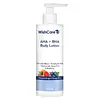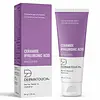What's inside
What's inside
 Key Ingredients
Key Ingredients

 Benefits
Benefits

 Concerns
Concerns

 Ingredients Side-by-side
Ingredients Side-by-side

Water
Skin ConditioningCoco-Glucoside
CleansingAcrylates Crosspolymer
AbsorbentSodium Cocoyl Glutamate
CleansingGlycerin
HumectantCocamidopropyl Betaine
CleansingSodium Lactate
BufferingAloe Barbadensis Leaf Extract
EmollientPropylene Glycol
HumectantSalicylic Acid
MaskingCamellia Sinensis Leaf Extract
AntimicrobialLactic Acid
BufferingGlycolic Acid
BufferingHydrogenated Castor Oil
EmollientMelaleuca Alternifolia Leaf Oil
AntioxidantChamomilla Vulgaris Extract
Skin ProtectingXanthan Gum
EmulsifyingEthylhexylglycerin
Skin ConditioningWater, Coco-Glucoside, Acrylates Crosspolymer, Sodium Cocoyl Glutamate, Glycerin, Cocamidopropyl Betaine, Sodium Lactate, Aloe Barbadensis Leaf Extract, Propylene Glycol, Salicylic Acid, Camellia Sinensis Leaf Extract, Lactic Acid, Glycolic Acid, Hydrogenated Castor Oil, Melaleuca Alternifolia Leaf Oil, Chamomilla Vulgaris Extract, Xanthan Gum, Ethylhexylglycerin
Water
Skin ConditioningGlycerin
HumectantSodium Acrylate/Sodium Acryloyldimethyl Taurate Copolymer
Emulsion StabilisingHydrogenated Polydecene
EmollientTrideceth-6
EmulsifyingSorbitan Laurate
EmulsifyingCetearyl Alcohol
EmollientCaprylic/Capric Triglyceride
MaskingSaccharide Isomerate
HumectantCitric Acid
BufferingSodium Citrate
BufferingBehenyl Alcohol
EmollientSorbitan Stearate
EmulsifyingSucrose Cocoate
EmulsifyingDicetyl Phosphate
EmulsifyingCeteth-10 Phosphate
CleansingCyclopentasiloxane
EmollientPhenyl Trimethicone
Skin ConditioningDimethiconol
EmollientC12-15 Alkyl Benzoate
AntimicrobialDimethicone Crosspolymer
Emulsion StabilisingPhenoxyethanol
PreservativeEthylhexylglycerin
Skin ConditioningAvena Sativa Kernel Flour
AbrasiveSodium Hyaluronate
HumectantPanthenol
Skin ConditioningLaminaria Digitata Extract
Skin ProtectingCetyl-Pg Hydroxyethyl Palmitamide
Skin ConditioningCeramide EOP
Skin ConditioningCeramide Ns
Skin ConditioningCeramide NP
Skin ConditioningCeramide AP
Skin ConditioningPhytosterols
Skin ConditioningDisodium EDTA
Pentaerythrityl Tetra-Di-T-Butyl Hydroxyhydrocinnamate
AntioxidantWater, Glycerin, Sodium Acrylate/Sodium Acryloyldimethyl Taurate Copolymer, Hydrogenated Polydecene, Trideceth-6, Sorbitan Laurate, Cetearyl Alcohol, Caprylic/Capric Triglyceride, Saccharide Isomerate, Citric Acid, Sodium Citrate, Behenyl Alcohol, Sorbitan Stearate, Sucrose Cocoate, Dicetyl Phosphate, Ceteth-10 Phosphate, Cyclopentasiloxane, Phenyl Trimethicone, Dimethiconol, C12-15 Alkyl Benzoate, Dimethicone Crosspolymer, Phenoxyethanol, Ethylhexylglycerin, Avena Sativa Kernel Flour, Sodium Hyaluronate, Panthenol, Laminaria Digitata Extract, Cetyl-Pg Hydroxyethyl Palmitamide, Ceramide EOP, Ceramide Ns, Ceramide NP, Ceramide AP, Phytosterols, Disodium EDTA, Pentaerythrityl Tetra-Di-T-Butyl Hydroxyhydrocinnamate
Ingredients Explained
These ingredients are found in both products.
Ingredients higher up in an ingredient list are typically present in a larger amount.
Ethylhexylglycerin (we can't pronounce this either) is commonly used as a preservative and skin softener. It is derived from glyceryl.
You might see Ethylhexylglycerin often paired with other preservatives such as phenoxyethanol. Ethylhexylglycerin has been found to increase the effectiveness of these other preservatives.
Glycerin is already naturally found in your skin. It helps moisturize and protect your skin.
A study from 2016 found glycerin to be more effective as a humectant than AHAs and hyaluronic acid.
As a humectant, it helps the skin stay hydrated by pulling moisture to your skin. The low molecular weight of glycerin allows it to pull moisture into the deeper layers of your skin.
Hydrated skin improves your skin barrier; Your skin barrier helps protect against irritants and bacteria.
Glycerin has also been found to have antimicrobial and antiviral properties. Due to these properties, glycerin is often used in wound and burn treatments.
In cosmetics, glycerin is usually derived from plants such as soybean or palm. However, it can also be sourced from animals, such as tallow or animal fat.
This ingredient is organic, colorless, odorless, and non-toxic.
Glycerin is the name for this ingredient in American English. British English uses Glycerol/Glycerine.
Learn more about GlycerinWater. It's the most common cosmetic ingredient of all. You'll usually see it at the top of ingredient lists, meaning that it makes up the largest part of the product.
So why is it so popular? Water most often acts as a solvent - this means that it helps dissolve other ingredients into the formulation.
You'll also recognize water as that liquid we all need to stay alive. If you see this, drink a glass of water. Stay hydrated!
Learn more about Water